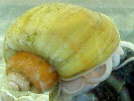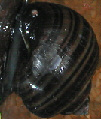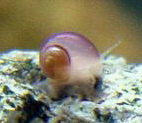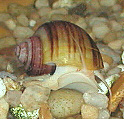
Bridgesiis are one of the few species of apple snails which has been cultivated to produce a wide variety of colors. These colors range from golden to green, and from ivory to purple. There are 3 primary factors in determining the color of a snail: the shell base color, the stripe color, and the foot color:

In the case of the snail above, the shell base color would be considered white (ivory), the stripe color purple (the picture is a bit faint), and the foot color white. (Any spots of orange or yellow pigments is NOT counted in the foot color). This is one of the rarest color types, but it serves as a good model for showing how to distinguish the color elements. Determining the color of a snail can sometimes be a bit tricky, especially where purples are concerned, and there is quite a bit of overlap between certain colors. There are even some colors which start out looking like another color, and then darken into their true color with age. However, for the majority of colors, and the most common colors, it is relatively easy to determine the color. The steps below can be used to figure out a snail's color type, assuming it is one of the commonly available types:
* Unfortunately, not all colors can be catigorized using those steps, since not all snails fall neatly into the descriptions. Striped Yellow is an example of this. While most Striped Yellow snails are relatively easy to distinguish, some purple forms masquerade as Striped Yellows until they are about 1/2" big, and then they suddenly begin to darken. The stripes become more purple, and the shell base can change color. This particular "morphing" color does not have a name as it is not very common, but so far it tends to be refered to as a "Brown Purple".
Since there is such a wide variety of colors, and descriptions alone can be vague or confusing, the following is a table of bridgesii colors, including common colors and some rare ones. All images are used with permission and are meant as examples to show the range that certain color types have. If a certain snail does not look 100% like one of the pictures, that doesn't mean it isn't the same color if it matches the text description. Please note that availablility is categorized by my own experiences and those of other people I know. Local availability of all colors will vary.
| Color Name | Description | Availability | Image |
| Ivory | The "albino" snail, although the color is not truely albinistic, as it posesses some pigment in the form of body spots. Their shell hue ranges from perfectly white, to slightly off-white or yellowish. These are often called "albino mystery snails". | Rare. Although there are numerous breeders of Ivories, they are still relatively rare in the pet trade. Large chains like Petco or Petsmart almost never carry them, though periodically they can be found through smaller privately owned stores. |  |
| Golden | The foot color ranges from white to yellow-ish, and the shell color ranges from opaque yellow to semi-transparent yellow. These are sometimes called "Inca Snails", or "Gold Mystery Snails". | Common.This is one of the most, if not the most common color type of bridgesii. Golden bridgesiis even outnumber wild-type bridgesiis in the pet trade at this point. These snails can be found at almost any large chain or private store that carries apple snails. |  My first golden, The Yellow Zeiplin |
| Striped Yellow | These look like a golden snail that has brown stripes. The stripes of these snails can be either brown or slightly purple-ish. In the latter case, the young snails tend to change color to purple as described earlier on the page. | Common. Rarer than Golds, but still often available at large chains and privately owned stores. |  |
| Wild Type | Dark body, yellow to brown shell base, and brown to black stripes. This color has a lot of variation between individals. The shell base can even become slightly greenish toned. | Common. Less common than Golds, but still readily available from most stores and other sources. |  |
| Jade | The dark-bodied version of a Golden snail. Jades have a dark body, with a shell that ranges from transparent yellow to very bright opaque yellow. There is a slight overlap between those with transparent yellow shells and some Blues. | Common/Rare. Depending on the area, Jades are either common or rare, depending on whether a company or local breeder is selling in that location. Jades can be purchased easily over the internet. |  |
| Blue | Dark bodied with a shell that ranges from completely white, to semi-transparent, in which case the dark blue-ish black body shines through. The thinner the shell, the more blue the snail looks. Blues with a very thick shell will just appear white shelled with a dark body. | Semi-Rare. Less common than jades. Some large chains get "accidental" shipments that contain blues mixed in with the ordered color. Privately owned stores periodically order them in with other hard-to-get colors. "Muddy" blues that are halfway between Jade and blue are much easier to find than the ones with a bright white and thin shell. |  |
| Red-White | Most likely this color is heavily overlaped with Light Striped Purple snails, so it is hard to distinguish the two. Red-Whites have a light body, and white/ivory to clear shell base, and their stripes can vary from being brown to redish-brown or slightly purple (hence the dificulty to distinguish this color from the Purples) | Very Rare. Almost impossible to get, and I have yet to see a true Red-White snail for sale. Most likely these are all called purples today. | No image available |
| Red-Brown | Red-Browns can often be hard to tell apart from Wild Types. they have a dark body, clear shell base (CLEAR, not off-white, etc), and red-ish brown stripes. The clear shell base is often very hard to identify as it lets the dark body shine through. | Rare, but periodically mixed in with shipments of wild-type snails. | No image available |
| Dark Striped Olive | Dark bodied snail with a green-ish shell base and stripes that range from red-ish brown to black or brown. Sometimes the shell base will have a blue tone. | Common. These are typically sold as the "Black Mystery Snail", since they can be so dark that they appear almost black. Available at most Petsmarts/Petcos that carry snails. |  |
| Dark Plain Olive | Green shell with dark body, no stripes. | Very Rare. | No image available |
| Striped Olive | Green shell with white body and brown/black/green stripes. | Very Rare. | No image available |
| Plain Olive | Green shell, white body, no stripes. | Very Rare. | No image available |
| Dark Striped Purple | Dark bodied with a pink to purple shell base, and dark purple or black stripes. These snails can be such a deep purple that they appear jet black and stripeless when taken out of the water. The ones with a more pink shell base tend to be brighter in color and easier to distinguish. | Rare. Dark striped purles are the easiest to get of all purples, but they are still hard to find. No large chains order them specifically to my knowledge, and most only end up getting them in as flukes among a mass of "Black Mystery Snails" (Dark Striped Olives). These "mistake" purples are usually the ones that are so dark they are almost black. |  |
| Dark Striped Purple (clear shell base) | Within the snails that look like dark striped purples, there are some that have a dark body, a CLEAR shell base, and dark purple stripes. In this case, the dark body shines through as blue-ish purple. These are nearly impossible to distinguish from dark striped purples that posess pink/purple shell base pigment, and so they are generally considered the "same" color. These snails are usually identified when a flash picture is taken, when the flash reflects off the clear shell layer and makes it appear white. | Rare. Not impossible to get, but much harder than the normal Dark Striped Purples. |  (picture with flash) |
| Dark Plain Purple | Dark bodied snails with a pink/purple shell base, and no stripes. | Rare. | No image available |
| Striped Purple | Light bodied snails with a pink/purple shell base and dark/bright purple stripes. These can be very striking critters, with unusually vibrant shell colors. The white body helps to accentuate the brightness of purple pigment in the shell. Somtimes the stripes are almost masked by the brightness of the underlying pigment. | Rare. Sometimes mixed up with shipments of "chesnut" (Striped yellow, I think?) snails. |  |
| Plain Purple | Light bodied snails with a pink/purple shell base and no stripes. Like Striped purples, the colors can be very bright. | Rare. Harder to come by than Striped Purples. Again, sometimes mixed up with shipments of "chesnut" snails. |  image contributed by naterose5 |
| Light Striped Purple (ivory version) | White bodied snails with a white to ivory shell base, and soft to bright purple stipes. They often have the appearance of a striped candy, and are quite nice looking animals. When the stripes are faint, they are hard to see at a distance and the snails sometimes look like very very light plain purples until seen in good light up close. | Rarest of all the purples. This is one of the newest colors, and therefore is only second to Red-Whites in being hard to come by. I suspect that most Red-Whites are now called Light Striped Purples because of confusion due to rarity. |  snail sent to me from BugBarb |
| Light Striped Purple (pink version) | Very similar to the true Light Striped Purples, except that they have one layer of very light pink pigment in the inner shell layer. They are white bodied snails with a pink to ivory shell base, and soft to purple stipes. They are usually "strawberry" in overall color, especially when a flash picture is taken. Some individuals have an apparently clear shell base until a flash is taken, and the pink reflects heavily (second picture). | Rare. This is one of the newer colors. |  (bright lighting) |
| Bugrundy | This is definitely a new color, linked to the appearance of striped purples. The body is white, and the color changes depending on the lighting and what angle the snail is held at: around the sides it has a deep burgundy hue (like wine), and in the highlighted areas it has yellow/copper overtones. It is, needless to say, a bizzare color as far as explaining its genetics is concerned. | Rare. This is one of the newer colors. |  |
| Dark Bugrundy | This is definitely a new color, linked to the appearance of striped purples. The body is dark blue-black and the color changes depending on the lighting and what angle the snail is held at: around the sides it has a deep burgundy hue (like wine), and in the highlighted areas it has yellow/copper overtones. Like the white-boded burgundy color, the genetics of this color are unknown. | Rare. This is one of the newer colors. |  |
Again, many of these colors are not reaily available through the pet trade. The purples in particular are hard to come by; they are a new color, occuring in the last couple of years, and have not had a chance to become recognized as distinct colors by many mass-breeders and almost all large petstore chains. In the apple snail community, there is an effort to establish a population of purples that breed true to the color, and to begin increasing purple snail numbers in the pet trade.
It should also be noted that because many of these colors are uncommon, their names have not been 100% standardized. The colors that are closest to having name standardization are Golden, Jade, Wild Type, Ivory, and Blue. All others tend to be refered to by different names depending on who is selling them, and sometimes the names are "fancied up" to make the color sound rarer than it really is. For instance, "Gold Inca Snails" (which can be either P. canaliculata or P. bridgesii) often sell for a little more than "Gold Bridgesiis". Sometimes it goes the other way too, not distinguishing color whatsoever, and I have seen some sellers that just put "Mystery Snail" on the front of a tank that has canaliculatas, bridgesiis of several colors, and even the livebearing Viviparids mixed up together.